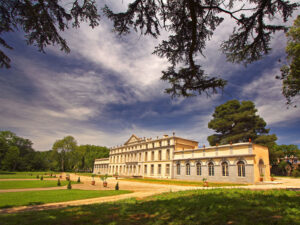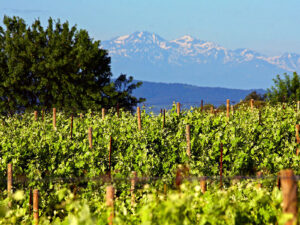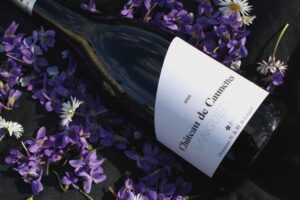Over twenty years ago, Nicolas and Miren de Lorgeril sought out vineyards at higher altitudes in the foothills of mountains in Southern France without any idea that climate change and global warming even existed. At the time, they were going against the grain in their Languedoc region as it was an area that was known for cheap wines and the stigma stuck even when producers were making high-quality wines, but at the time, it was thought that if winemakers made very ripe, concentrated wines with lots of density then they would be taken seriously. But Miren and Nicolas were young and pulled away from other opportunities to help with Nicolas’ family vineyards as his mother was getting tired and the dream of his father, who passed 15 years earlier, had not been fully realized.
Not only would Nicolas’ father’s dream eventually be fully realized but that dream would be taken to heights that he could have never imagined.
Maison Lorgeril
The Lorgeril family has been the caretaker of a precious Languedoc estate, Château de Pennautier, since 1620, so their roots go deep within this southern region of France. But like many other wine regions in Europe in the mid to late 1800s, the devastating pest phylloxera destroyed the vineyards of the Languedoc, forcing its local economy into a tailspin. And despite their historic family estate standing as a glorious monument for the area, known as the Versailles of the South, times were extremely tough for the local people and the Lorgeril family. And so people could no longer plant vineyards on the hillside, as quantity was more important than quality because locals were just drinking during those desperate times to gain enough calories to work, and hence, the vineyards were relegated to the fertile lower plains. “My husband’s grandmother sold hillside land so she could afford to buy the land in the plains for growing grapes,” noted Miren de Lorgeril, as the mentality is undoubtedly the opposite today, with the hillside being much more greatly valued.
When Miren and her husband, Nicolas de Lorgeril, were first married, he was pursuing another career outside of winemaking and she was working for another producer in the Rhône Valley – not that far from the Languedoc, and then Nicolas received word from his mother that she had reached an age where it became too much to oversee their Maison Lorgeril family estates and that he needed to take over. Miren immediately followed her husband to the Languedoc and at the top of their agenda was to produce fresh, elegant wines. Immediately they went to each estate to notify the winemaker, to his disbelief, that freshness and elegance were preferred over intense concentration.
Miren and Nicolas fiercely worked to make elegant wines from their vineyards that were managed with sustainable practices while also pursuing sales in other countries all around the world instead of continuing the tradition of selling through a local wine merchant, as the wine merchant was all about taking the easy path of selling the wines as bargains completely ignoring the lovely sense of place that their wines were displaying. During this time, Nicolas continued his other career helping finance the significant changes necessary to bring his family’s wine business to the next level.
Reaching for Greater Heights
After many years of trying to break into various European and Asian markets, Miren and Nicolas decided that they needed to buy more estates throughout Languedoc as well as their neighboring region Roussillon. Many of the distributors from other countries were impressed by their wines at the time, yet they needed a broader range of styles, grapes and terroirs to have any chance of entering international markets. And this became the motivator for the Lorgerils to buy more vineyards in different areas, vineyards that were high-elevation sites within the Languedoc-Roussillon that ranged between 400 to 1,200 feet above sea level. If they were going to put everything on the line to make the world stop and appreciate the brightness and elegance that came from their region, they would go all in and choose the vineyards that they thought represented the best of the Languedoc and Roussillon. And then, in 2000, they released the first vintage of their wines labeled ‘Terroirs d’Altitude,’ bringing a focus to their cooler climate sites which went against the big and robust wines that the Languedoc had built its reputation on.
Now, as many parts of the world are experiencing record heat waves such as what happened to various parts of the Western world during this past summer, the Lorgerils couldn’t be happier that the choices they made so long ago, when they had no knowledge of climate change, are benefiting them today and guaranteeing a solid future for their children.
Dynamic Wine Region
There are many European wine regions where the locals resent outsiders buying estates and making wine. And although Nicolas de Lorgeril traces his family back to 1620 in the Languedoc, he and his wife love that there is no over-evaluation of their land as it allows young people from all over to purchase vineyards in the Languedoc to pursue their dreams, bringing with them lots of creativity and a dynamic energy that has helped to make much of the wine region organic, and the Lorgerils became organic ten years ago. Miren de Lorgeril said it is a big contrast to when they first came to the Languedoc as it seemed impossible to get the world to take them seriously as a wine region. Yet today, the Languedoc is becoming a place where many retail stores and restaurants around the world want to source their French wine selections as the wine producers are finding an ideal balance of ripeness and freshness in higher-elevation sites, it is extremely easy to be organic there and the prices are very reasonable.
All those years ago, Nicolas de Lorgeril’s father believed that the Languedoc could become a high-quality French wine region, even in the shadow of Bordeaux and Burgundy, and he wrote precise instructions for his wife to follow to make high-quality wine in case of his death. And in a way, that paper has become the greatest treasure he could leave his family as it gave hope for a brighter future – he was determined that his beloved region would not fall into obscurity, with many abandoning vineyards for other crops.
But maybe he couldn’t imagine that his son and daughter-in-law would sell the family’s wines all over the world and that people from different places would move to the Languedoc because they saw the potential of it becoming the next exciting wine region in Europe. Or maybe, just maybe he could imagine all of this, and more to come, as he sat gazing at his stunning Château de Pennautier estate, knowing that even though locals were living hand to mouth, that just like his glorious palace, the best vineyards were waiting to be discovered by the world. And once they were, the world would completely be taken by the beauty that came from his home.
***Link to original article published on Forbes: https://www.forbes.com/sites/cathrinetodd/2022/11/10/investment-in-mountain-vineyards-pays-off-for-a-wine-producer-in-southern-france/
Maison Lorgeril Languedoc Rosé
2021 Maison Lorgeril, Ô de Rosé, Languedoc, France: 60% Grenache, 35% Syrah and 5% Viognier harvested from three different estates in the Languedoc and then vinified together. Lovely white cherry notes and wet stones with a touch of raspberry on the finish.
Maison Lorgeril ‘Terroirs d’Altitude’ Estate Wines
2020 Marquis de Pennautier, Chardonnay, Cabardès, Languedoc, France: 100% Chardonnay from their historic Pennautier estate in the hilltop town of Carcassonne in Languedoc. In a north-facing site that ranges from 750 to 1,200 feet in altitude. Lemon curd flavors with hints of minerality and a creaminess on the mid-palate with spices and bright acidity. And this Chardonnay is one of their most popular wines, which may seem odd considering Chardonnay’s spiritual home, Burgundy, is just north of them. But the balance of just enough fruit ripeness with the bright acidity and minerality at a moderate price point has made this wine a big seller.
2019 Château de Caunettes, Cabardès, Languedoc, France: Red blend of 60% Syrah and 40% Grenache. Upheaved earth with turmeric powder and cardamom pods balanced by black cherry juicy fruit.
2019 Château de Ciffre, Saint-Chinian, Languedoc, France: Red blend of 50% Syrah, 40% Grenache and 10% Mourvèdre. Fresh blackberries with a touch of leather and bacon fat with finely etched tannins.
2019 Domaine de la Borie Blanche, Minervois la Liviniere, Languedoc, France: Red blend of 70% Syrah, 20% Mourvèdre and 10% Grenache. Red blend of Syrah (of which 50% is grown on schist soils and 20% undergoes carbonic maceration) and the rest Mourvèdre and Grenache. Hints of black pepper on the nose with wild mushrooms and wildflowers in the background and good weight on the palate with fresh mulberry fruit and black cherries finishing with silky tannins.














